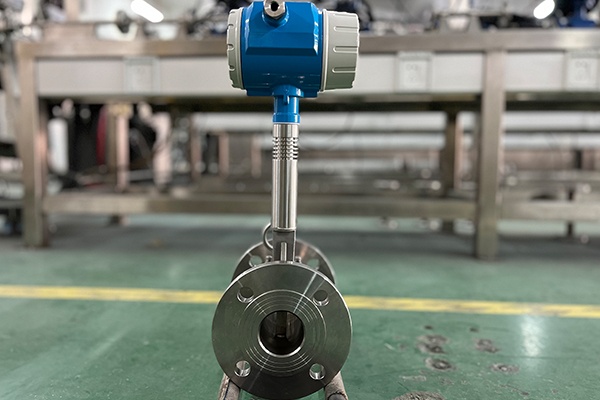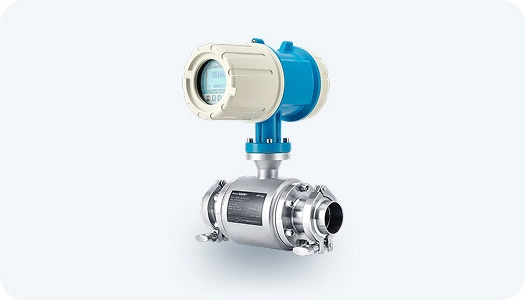-
Date:2025-09-25
-
Page View:76
A vortex flow measurement is a volumetric flowmeter that measures the volumetric, standardized volumetric, or mass flow rate of gases, steam, or liquids based on the Kármán vortex principle. It is primarily used to measure the flow rate of media within industrial pipelines, including gases, liquids, and steam, encompassing both liquid and gas flow meters.
How Does Vortex Flow Measurement Work?
When fluid passes a stationary object, it generates alternating vortices that shed downstream. The frequency of this vortex shedding is directly proportional to the fluid velocity.
The flowmeter operates on this principle: a vortex sensor with an integral bluff body is installed in the pipeline. As fluid flows past, the bluff body causes the formation of a vortex street. By detecting the frequency of the resulting pressure or vibration fluctuations, the flow rate of the fluid can be accurately calculated.
Advantages of Vortex Flow Measurement
Wide Range of Applications: Vortex flow meters are suitable for measuring the flow of liquids, gases, and steam across a wide range of temperatures, pressures, and viscosities. They find applications in industries such as chemical processing, oil and gas, water and wastewater, and HVAC systems.
High Accuracy: Vortex flow sensors provide accurate flow measurements, typically within ±0.75% to ±1.0% uncertainty. This level of precision makes them suitable for critical processes in need of precise flow control and monitoring.
Low Pressure Drop: Vortex flow measurements have a low pressure drop, and this indicates that they cause minimal resistance to flow. This characteristic is beneficial in applications where energy conservation and maintaining system efficiency are important considerations.
Low Maintenance Costs: With no moving parts, vortex flowmeters are highly reliable, require minimal maintenance, and minimize downtime. Their simple and robust design ensures long-term operational reliability. This advantage is crucial for cost savings and improved operational efficiency.
Applications of Vortex Flow Measurement
The vortex flow measurement is suitable for measuring the flow rate of most liquids and gases, proving particularly effective in applications involving high temperatures, high pressures, or corrosive media. It is widely used for flow measurement across various industries, including petrochemicals, power generation, steel, chemicals, and water conservancy.
This type of flowmeter can measure a diverse range of media. Common liquid applications include water, petroleum, and acid-base solutions, while typical gas applications involve natural gas, coal gas, and air. In water management systems, vortex flowmeters play a crucial role in measuring water flow within pipes and channels. Other key application areas include HVAC systems, food and beverage production, and pharmaceutical manufacturing.

Vortex Flow Measurement

Vortex Flowmeters
How to Select the Right Vortex Flow Measurement?
Fluid Medium: Vortex flowmeters are suitable for measuring the flow of various liquids, gases, and steam. However, the properties and state of the medium directly impact the selection. For instance, when measuring high-temperature, high-pressure, or corrosive media, a flowmeter constructed from materials resistant to these conditions must be chosen.
Flow Range: Different models of vortex flowmeters are designed for specific flow ranges. To ensure measurement accuracy and reliability, select a model and size that matches the actual expected flow rates.
Pipe Size: The measurement accuracy and sensitivity of a vortex flowmeter are closely related to the pipe diameter. It is essential to choose a flowmeter sized correctly for the pipeline's inner diameter to guarantee precision and stability.
Accuracy Requirements: Vortex flowmeter models offer different levels of measurement accuracy. The selection should be based on the specific accuracy needs of the application to choose a device with an appropriate performance level.
Environmental Conditions: Ambient conditions can affect the flowmeter's performance and selection. Factors such as extreme temperatures (high or low), high or low pressure, corrosion, and vibration must be considered. Therefore, choose a model and specifications that are suitable for the actual operating environment.
Maintenance: Vortex flowmeters require periodic maintenance to ensure long-term accuracy and reliability. When selecting a flowmeter, consider the ease and cost of maintenance, opting for a design that is easy to service.
Common Types of Vortex Flow Measurement
Vortex flowmeters come in various types, each with distinct advantages and specific considerations. They are primarily classified by sensor and installation configuration into flanged, wafer-type (clamp-in), and insertion styles, as well as models integrated with temperature and pressure compensation.
These compensated models can simultaneously measure temperature, pressure, and flow rate. This versatility in design allows for the selection of an optimal flowmeter tailored to different installation environments and application requirements.
Vortex Flowmeter with Temp & Pressure Compensation
For Gases: Simultaneous temperature and pressure compensation is required. Gas flow is typically calculated and billed based on standard volumetric flow rate. This is because the volumetric flow of a gas changes with variations in either temperature or pressure.
For Superheated Steam: Simultaneous temperature and pressure compensation is required. Steam flow is typically settled by mass flow rate. If either the temperature or pressure changes, the density of the superheated steam changes, consequently altering the mass flow rate.
For Saturated Steam: Either single temperature or single pressure compensation is sufficient. The density of saturated steam has a fixed relationship with its temperature or pressure (as defined in a saturated steam table). Knowing either value allows for accurate determination of the density.
Installation and Maintenance of Vortex Flow Measurement
The flowmeter should be installed in a section of the pipeline where the flow is stable, and free from bubbles or impurities to avoid signal interference. During installation, ensure sufficient straight pipe runs upstream and downstream as required to establish a uniform flow profile before the fluid reaches the meter.
Regular maintenance and calibration are crucial for ensuring long-term stability and accuracy. Since vortex flowmeters have no moving parts, their maintenance requirements are relatively low. Nevertheless, periodic performance checks are essential to verify continued measurement precision.
Vortex flow measurement offers an accurate, reliable, and cost-effective solution for monitoring fluid flow in various industries. Its non-intrusive nature, wide turndown ratio, and low maintenance requirements make it a preferred choice for many applications. However, proper consideration of fluid properties, installation techniques, and potential limitations is essential to ensure accurate and consistent measurements. As technology advances, vortex flow meters are likely to become even more versatile and adaptable to evolving industry needs.










